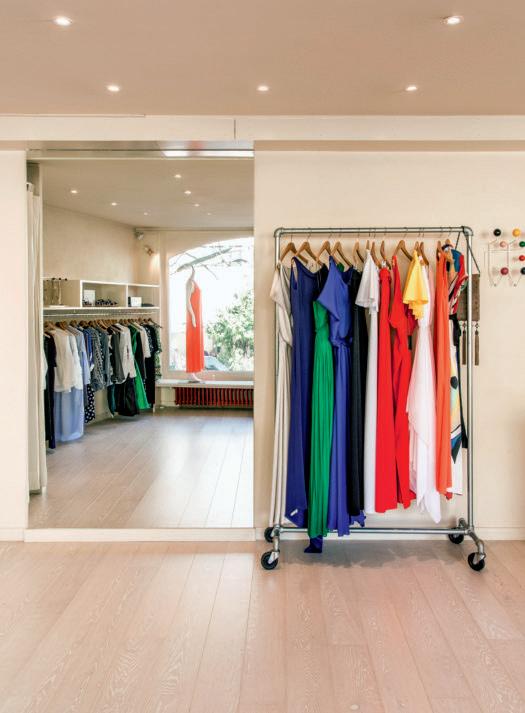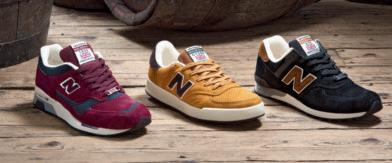
8 minute read
Luxury or Quality?
How do you define luxury in the shoe business? Is it the brand name? Or is it excellent quality? Ever since the big brands have come under criticism for their high prices, many a buyer has started re-thinking old strategies. Text: Ina Köhler. Illustration: Claudia Meitert @Caroline Seidler
Ultimately, buyers need to select what their customers want. These customers tend to turn to the supposed security of a larger brand when a certain price level is breached. Gianni Klemera, an Italian agent, explains: “I think you have to separate the topic. Luxury is defined, on the one hand, by high and highest quality. On the other hand, it is also defined by the story of a brand. Parallel to real luxury manufacturers such as Giuseppe Zanotti, Louboutin, and Jimmy Choo, we have witnessed the creation of a market dominated by designer names and marketing. In my eyes, examples include Prada, Ferragamo, and Gucci. This applies even more for what we call luxury sneakers. The latter are offered at a price that merely mirrors the image, certainly not the quality. However, they are highly relevant to the market due to social media campaigns.” The exclusivity debate turns particularly absurd in the case of marketing-driven products such as the aforementioned luxury sneakers. The limited Yeezy Sneakers, a collaboration between Kanye West and Adidas, sold for 350 Euros and were sold out almost immediately. On Ebay, the price for the “exclusive” sneakers made in China can soar as high as 3,000 Euros.
Pressure on Luxury Market The retail industry also feels the increasing pressure. “The luxury market has become increasingly difficult to serve over the last five years”, say Andrea and Franz Wunderl, the owners of Schuhhaus Wunderl in Sollenau. On the one hand, they blame factors like the financial crisis and greater pensiveness of consumers. “On the other hand, the luxury sector is troubled by declining sales in a period of creative stagnation.” Their product range includes brands such as Prada, Miu Miu, and Linea Rossa, as well as Tods. In addition, they complement their range with models by, for instance, Gianvito Rossi, Chloé, Stuart Weitzman,
“Our customers visit us because they crave individuality.” Henning Korb, Apropos
and others. While the product range changes from season to season, the constant remains the focus on quality. “The brand is important to many customers, but rather as a quality feature than in the sense of ‘must haves’ or stubborn brand fixation”, Andrea and Franz Wunderl add.”Those days are long gone among our mature customers.” The luxury store Apropos focuses on a mix of well-known brands and newcomers. “Our customers visit us because they crave individuality. This individuality is offered by high-end collections with a special design and a high degree of exclusivity”, Henning Korb, the buyer of Apropos, explains. “There are several examples where successful luxury brands almost disappeared from the market within a few seasons, mainly because they were over-distributed and became increasingly irrelevant to the buyers. The main reason why the Louboutin hype is still holding up is the selective distribution strategy. Naturally, the collections are also always fantastic. That is indisputable.”
Quality as Top Priority Everybody agrees that the quality has to be paramount. “Value for money is a big issue. Customers notice that the manufacturers raise prices from season to season, which makes some labels implausible in the long term”, Apropos’ Henning Korb suggests. However, it isn’t easy for new brands to break into the market. The most likely candidates are new brands that are backed by manufacturers with a lot of experience, such as Sergio Rossi’s son, Gianvito Rossi, who launched his brand in 2006. He managed to thrill editors and buyers alike right from the start. The brand of his father, Sergio Rossi, had been sold to Gucci Group years earlier. Gianvito Rossi also convinced the owners of Wunderl back then: “You don’t have the luxury to experi
“Many customers have to be convinced that they can trust a new brand in this price range.” Jörg Remberg, Cheaney & Sons
ment with new brands as much as you might have done 15 to 20 years ago”, Andrea and Franz Wunderl say. “In the case of Gianvito Rossi, we were invited by Gianvito, who we already knew from the Sergio Rossi era, to take a look at his project before the launch of the first collection. We were enthusiastic about it straight away and have been loyal customers ever since.”
“This is a highly consulting-intensive business”, Jörg Remberg, whose agency represents the British men’s footwear brand Cheaney & Sons, confirms. “Many customers have to be convinced that they can trust a new brand in this price range.” The experience of a well-known luxury brand helped the cousins Jonathan and William Church to establish the footwear brand Cheaney & Sons. After selling their Church brand to luxury group Prada, they took over the tradition-steeped company Cheaney & Sons, which had produced for Church for decades, via a management buy-out in 2009. Today, this company manufactures classic shoes “Made in Great Britain” under its own name. Joseph Cheaney & Sons was founded as early as 1886 in Northamptonshire, which is a traditional centre for
The brand is important to many customers, but rather as a quality feature.” Franz und Andrea Wunderl
the British shoemaking craft. But it needed the dedication and expertise of the successful Church founders to bring Cheaney & Sons back to life. Much emphasis is placed on the tradition of craftsmanship and the know-how of the 120-strong workforce, which is capable of fulfilling individual wishes. “It is vital to provide excellent quality at a reasonable price on a consistent basis”, Remberg adds. “That’s the only way to compete with the large brands.”
Reasonable Prices as Entry Point “I believe that new brands have to stand their ground by offering high quality and an appropriate price-performance ratio, especially when they don’t have a corresponding marketing budget”, Gianni Klemera confirms. “The consumer of today is very knowledgeable, especially regarding prices.” Charline de Luca, a young designer who was selected by the GDS trade show for this year’s project “Design Trendsetter”, shares this view. “As a newcomer, it’s really important to offer a good price-performance ratio, especially as you’ll find your products right next to the large brands in the stores. The entrance price is important, as it is what gets you into the business. However, it is even more important to have a special element in your design, which makes your product recognisable and nobody else has. The big brands are everywhere, but I do have the impression that the stores are still open to new ideas.” Many stores stock luxury brands as eye-catchers, but there is a lot of room below at retail prices of slightly less than 300 Euros. “Retailers are looking for brands that guarantee good margins”, Gianni Klemera points out. “If a product is good, it’s not hard to reach many top retailers right at the start.” This experience is also shared by the newcomers Ancient Greek Sandals, the Greek-produced brand of Christina Martina and Nikolaus Minoglou. “We were lucky enough to be present in more than 30 countries from the start. Our distribution agency Rainbowwave Ltd did an awesome job for us.” The importance of finding the right agency should not be underestimated. “Ultimately, the customer knows that I have given this a lot of thought. The production and distribution are guaranteed”, Klemera adds. Yet it also requires openness on the part of the buyers. We need experiments. We need bold decisions. And we need events that showcase footwear in all its glory. A shining example is a recent co-operation between the GDS trade show and the Düsseldorf branch of Breuninger, which resulted in a three-day pop-up area showcasing designers such as Alain Tondowski, Charline de Luca, Laurence Dacade, and Ancient Greek Sandals. The inspiration came from the “Design Trendsetter” initiative, which was first introduced by the GDS trade fair in spring. “We had
“The industry needs to support its creative talents.” Kirstin Deutelmoser, Director GDS
been engaged in talks regarding a collaboration with the trade show for quite a while. Now we are very happy about this event”, says Andreas Rebbelmund, the managing director of Breuninger Düsseldorf. “The designers can present their products and the three-day pop-up store is an extremely special range for our customers. Ultimately, it’s a win-win situation for everyone involved.” This is also confirmed by Annalise Damico, the sales manager of Alain Tondowski: “Such events
“As a newcomer, it’s really important to offer a good price-performance ratio.” Charline de Luca
are incredibly important for the shoe industry. The shoe retailers need to become more open to new products.” In principle, the shoe retail industry is already open, but the stores have their own criteria. For example, Apropos stocks new names, such as the CFDA Award winner Paul Andrew, Tory Burch, and the slip-ons designed by blogger Chiara Ferragni, alongside the luxury brands such as Louboutin. “First and foremost, the collection needs to blend in with our aesthetic approach. That’s the most important aspect”, says buyer Henning Korb. “If this criterion is met, we then look at exclusivity and quality, as well as the fit. In our industry, marketing activities can often be decisive. When a brand is promoted by an excellent advertising campaign, it makes the product more attractive.”
Design Trendsetter With the “Design Trendsetter Area”, which was first introduced in spring 2015, the GDS trade show created a platform for innovative shoes and accessories. The separate area within the “Studio” segment showcases a total of 20 international designers and their products. The selection was made by Kirstin Deutelmoser, the managing director of GDS, as well as international experts such as Giuseppe Baiardo, Onward Luxury Group, Ernesto Esposito, and Veronique Branquinho. The main selection criteria were creative potential and product quality. The new area showcased designers and brands such as Laurence Dacade, Alain Tondowski, Charline de Luca, Casamadre, Ancient Greek Sandals, and Finsk. Some of their products are already sold worldwide at top retailers such as Colette, 10 Corso Como, Selfridges, Joseph, Bergdorf Goodman, and Saks. The project will initially run for two seasons. Kirstin Deutelmoser believes that the industry needs to support its creative talents. “In addition, we want to create real additional value for our visitors.” www.designtrendsetter.com
1 9 – 2 1 J A N U A R Y 2 0 1 6











